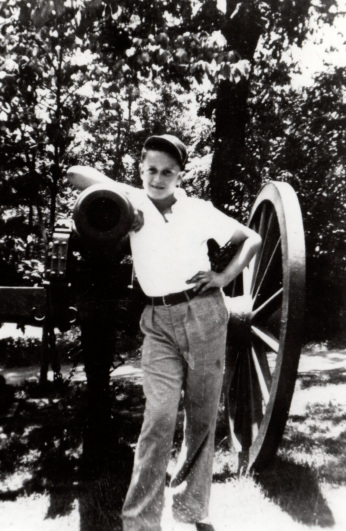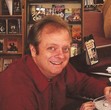The Last Reunion (part 3)
Note: As the publication of my new book, Clay Soldiers: One Marine’s Story of War, Art, & Atomic Energy draws closer, I thought that I would give you a preview of the book by publishing the first chapter over the next few weeks. The story is a biography of Chuck Caldwell, a WWII Marine who fought at Tarawa and Guadalcanal. He also worked in Nevada with the above-ground atomic bomb tests, attended the 75th, 100th, 125th and 150th anniversaries of the Battle of Gettysburg, and is a sculptor of miniature figures that are highly sought after. If you are interested in pre-ordering a copy of the book at a 25% discount off the cover price and free shipping in the U.S., contact me at jimrada@yahoo.com. As always, let me know what you think.With the seventy-fifth anniversary of the Civil War beginning in 1936, many newspapers started running features about the veterans who lived in their circulation areas. The articles allowed the veterans to recount their war-time experiences from seventy-five years earlier. Chuck had read as many of the articles as he could find so he had been overjoyed to find out that he and his father would be traveling to Gettysburg for the last, great anniversary.

Fourteen-year-old Chuck Caldwell on the Gettysburg Battlefield in 1938.
Most of the veterans had arrived earlier the same day that Chuck and his father had arrived on twelve special Pullman trains. Some of them were so frail that they had to be carried off of the trains on stretchers.
The Gettysburg that the Caldwells drove into in 1938 was a much larger town than the Gettysburg of two years prior. Not larger in terms of size, but in the number of people. Cars crept along the roads, bumper to bumper. Tents were pitched in open fields forming small communities. People clustered tightly on sidewalks, reminding Chuck of pictures he had seen of big cities like New York and Philadelphia. Many of the people on the sidewalks were probably from those cities and thinking about how uncrowded Gettysburg was.
Because of the expected crowds, the borough had worked to make a good impression on visitors and veterans alike. In the weeks leading up to the reunion, workmen had repaired all of the streets leading into Gettysburg and removed any weeds along the sidewalks. Flags were draped across the streets—Chambersburg, York, Baltimore, and Carlisle—leading from the town square. Business windows were filled with displays about the anniversary. Public buildings were festooned with flags. The borough had even arranged for many of the buildings to receive a fresh coat of paint. At night, the town was lit up with red, white, and blue lights.
The Gettysburg Times reported, “Gettysburg will present its brightest and gayest appearance in 25 years.” One Confederate veteran’s wife said all of the activity and decorations in town reminded her of a huge street carnival.
Tim Murphy of Harrisburg was a big reason for this declaration. Murphy had worked in event promotion and decorating for more than twenty-five years. He had learned showmanship from working with the Barnum and Bailey’s Circus and Buffalo Bill’s Wild West Show. He had also decorated Washington, D.C. for the inaugurations of Franklin D. Roosevelt, Calvin Coolidge, and Warren G. Harding. Perhaps most importantly, he had helped decorate Gettysburg for the Grand Reunion of 1913 when 57,000 Civil War veterans had come to Gettysburg to remember the battle and their days in the Blue or the Gray. Chuck’s head swung back and forth anxiously looking for Civil War veterans in the crowd, but he didn’t see anyone whom he could point to and say, “I want to meet him!” Most of the men wore nice suits, though some of them had forsaken their jackets because of the heat. They were far too young to have served in the Civil War. Chuck did see some men in brown uniforms, but they were modern soldiers.
While the Caldwells hadn’t needed to make a room reservation two years ago, this year, each innkeeper, tourist court owner, and motel manager with whom they inquired told them the same thing. They had arrived too late in the day. All of their rooms were filled. Try back around lunch time tomorrow.
With each rejection, it looked like it was less likely that Chuck and his father would find a place to stay for the night at least in Gettysburg. Both of them dreaded getting back in the car to drive on to Biglerville, New Oxford, or Emmitsburg in search of a room.
A farmer saved the day for them. George Caldwell started talking to the man on the street, hoping to get a lead as to where he could find a room in town. The farmer agreed with everyone else that all of the rooms were filled with tourists visiting for the seventy-fifth anniversary of the battle. Then he offered the Caldwells the use of his old chicken coop, which was currently vacant.
That was why Chuck found himself waking up in a chicken coop on July 1, 1938, rather than a bed. He shook his father awake and they washed up in the farmer’s house, changed clothes and drove back into Gettysburg.
One night in a chicken coop had been enough for the Caldwells. George made sure that he took part of the afternoon to revisit the tourist camps and hotels in town until they found a place to stay that offered them a real bed without any ventilation through the floor.
The Civil War veterans weren’t staying in hotels or inns, either. Even though their rooms were tents, they were five-star accommodations compared to a chicken coop.
The veterans’ camp had been constructed on the north end of Gettysburg College and also on some adjacent privately owned property. The Pennsylvania Blue and Gray Planning Commission had decided to house the veterans in tents just as had been done during the 1913 reunion when more than 6,500 tents had been erected in a temporary camp south of Gettysburg. Although far fewer veterans attended the seventy-fifth anniversary reunion, there simply wasn’t enough room for all of them in hotels and constructing wooden barracks would have been too costly.
Planning for the seventy-fifth anniversary reunion had begun in 1935, but men of the Civilian Conservation Corps hadn’t started construction of the camp until April 26, 1938. Leonard Shealer, one the workers who helped build the camp, hauled wood to build the camp boardwalks and tent frames. Once the reunion activities began, Shealer hauled garbage from the kitchen in his truck and also slept there.
Boardwalk streets were laid out in a grid fashion. Union veteran tents were located on lettered streets from Biglerville Road to Mummasburg Road. Confederate veteran tents lined numbered streets from Mummasburg Road to the Reading Railroad. The Confederate and Union sections of the camp were split by Mummasburg Road.
Each veteran was given either a United States flag or a Confederate flag to display in front of his tent if he wanted to do so. Annette Tucker, wife of a Confederate veteran at the reunion, wrote, “At the time I felt so loyal to the Government for making this meeting possible and for all the favors they were bestowing upon us that it didn’t seem proper to display the Confederate flag, not even at the Reunion, even if we were permitted this privilege, so I folded mine to bring home for a souvenir and perhaps use at our own U. D. C. meetings.”
Short wooden walks ran off the streets at right angles leading to the nine-foot by nine-foot tents. Each tent had two cots; one for the veteran and one for his attendant. They had wash stands and electric lights in them. The tents also had rain flys in front of them that offered shade so that the veteran could sit outside and talk to his neighbors or greet passersby by like Chuck.
“It was a thrill to be able to see both armies together at one time. It was just too much. I would have walked from home to be there,” Chuck said.
The men Chuck saw seemed frail in comparison to the soldiers they had been in their youth. Now in their nineties and even their hundreds, their hair, if they still had any, was white along with their sideburns, mustaches, and goatees. Many of them could stand for only short stretches and spent most of their time sitting in wheelchairs supplied by the reunion commission.
Nearly all of them dressed in coats, vests, and neckties. Here and there, one of the veterans would dress in a shabby military uniform that was seventy-five years old. This was their special reunion and their time in the national spotlight. They wanted to make a good first impression with people they met.
Unsigned article, “Plans Completed for Gettysburg’s Big Celebration,” The (Beaver County, PA) Daily Times, June 28, 1938, p. 1.
Annette Tucker, “The Gettysburg Reunion – 1938”, unpublished manuscript at the Adams County Historical Society, p. 3.
Unsigned article, “Flags, Bunting Brighten Town for Battle Fete,” The Gettysburg Times, June 23, 1938, 1.
Annette Tucker, “The Gettysburg Reunion – 1938”, unpublished manuscript at the Adams County Historical Society, p. 3.
Unsigned article, “Flags, Bunting Brighten Town for Battle Fete,” June 23, 1938.
Author interview with Chuck Caldwell.
Stan Coben, Hands Across the Wall: The 50th and 75th Reunions of the Gettysburg Battle (Charleston, WV: Pictorial Histories Publishing Co., 2011) pp. 40-1.
Jess Haines, “95-year-old remembers role in 75th, 1938 reunion,” The Gettysburg Times, June 30, 2012, pg. 1.
Unsigned article, “Many People Visit College During Celebration,” The Gettysburg College Bulletin, October 1938, 2.
Annette Tucker, “The Gettysburg Reunion – 1938”, unpublished manuscript at the Adams County Historical Society, p. 3.
Annette Tucker, “The Gettysburg Reunion – 1938”, unpublished manuscript at the Adams County Historical Society, p. 5-6.





